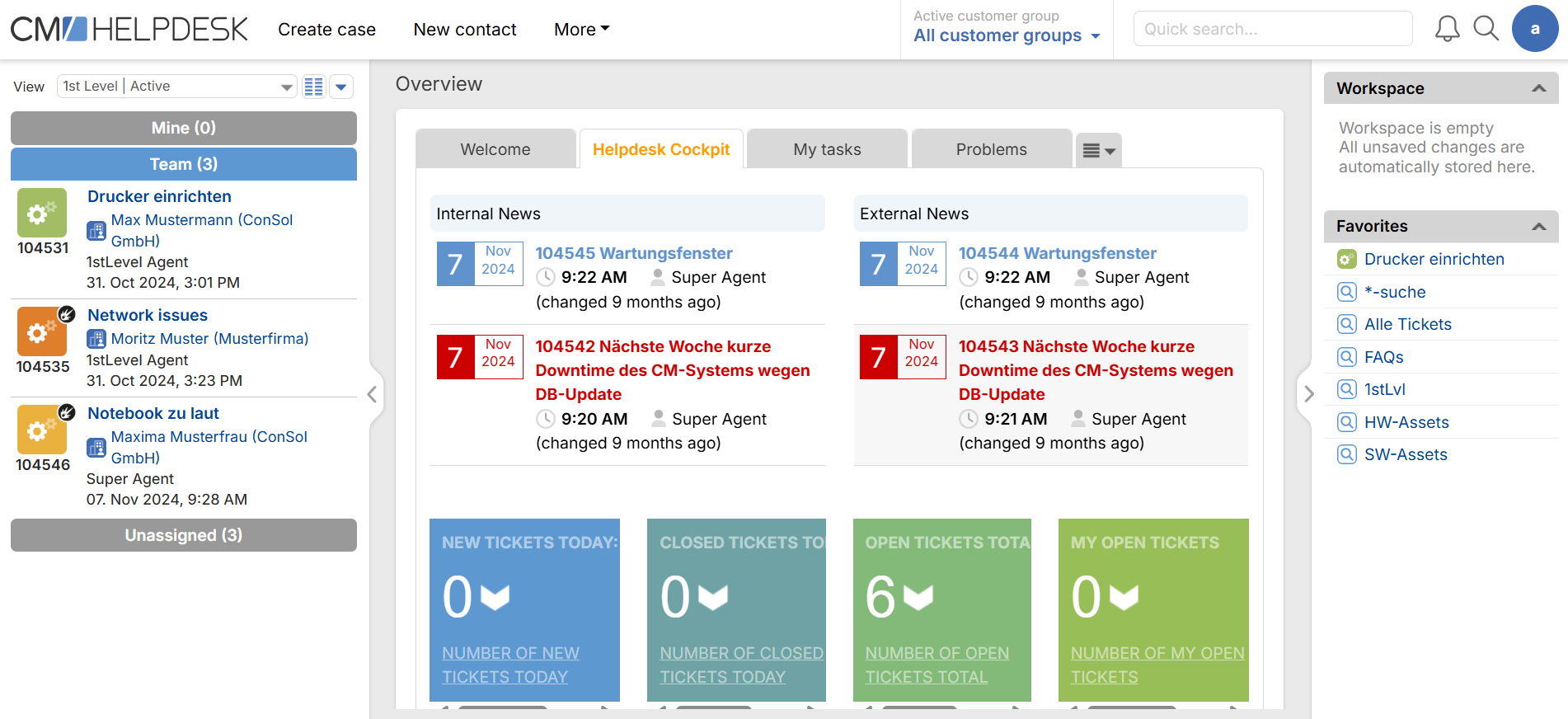CM/Helpdesk
ConSol CM/Helpdesk is a pragmatic solution for your IT service to speed up helpdesk and technical support. The processes are based on the proven ITIL standard for IT service management.
Requests and fault reports are first received by 1st-level support. After initial analysis, they can be linked to stored assets from the CMDB and forwarded to a second-level team if necessary. SLA calculations are performed automatically in the background. You can create specific problems and changes for tracking purposes. CM/EBIA is integrated into the dashboard for reporting and evaluation.
Getting started
Registration and integrated tutorial
Register by entering a user name and password. The following users are available in demo environments:
- hd_1stAgent: All permissions for 1st level tickets, tasks and customer data; read permissions for other processes, assets and SLAs
- hd_2ndAgent: All permissions for 2nd level tickets, tasks and customer data; read permissions for other processes, assets and SLAs
- hd_problemAgent: All permissions for problems, tasks and customer data; read permissions for other processes, assets and SLAs
- hd_changeAgent: All permissions for changes, tasks and customer data; read permissions for other processes, assets and SLAs
- hd_approver: All permissions for changes, tasks and customer data; read permissions for other processes, assets and SLAs; selectable as approver
- hd_faqAdmin: All permissions for FAQs
- hd_newsAdmin: All permissions for news
- hd_assetAdmin: All permissions for assets (end devices and software)
- hd_slaAdmin: All permissions for SLAs
- hd_ebiaAdmin: All permissions for CM/EBIA (reporting)
- hd_templateAdmin: All permissions for text templates
- hd_SuperAgent: All permissions
When you log in with the user hd_1stAgent, you can click on Start tutorial at the bottom of the screen to view a short tutorial for initial orientation.
Processes and cases in CM/Helpdesk
CM/Helpdesk has three input channels for creating procedures:
- CM/Track customer portal: Contacts can submit enquiries using a form in the customer portal.
- Email: Contacts can send emails to the support address.
- Manually: As the agent, you create a process manually, e.g. if a contact has called you on the phone.
There are several types of processes in CM/Helpdesk:
- Incident/malfunction and request/order: The initial enquiry from the contact is treated as an incident or request and processed at the 1st level and 2nd level, see Incident management.
- Problem: A problem is the cause of one or more incidents, see Problem management.
- Change: A change is a modification that is necessary to resolve an incident or problem, see Change management.
- Task: Tasks are individual steps that must be performed to handle an incident, problem or change, see Tasks.
- News: News items inform customers and employees about current planned downtimes, disruptions or innovations. External news for customers is published in CM/Track. Internal news for employees is displayed directly on the start page in the Web Client, see News.
- FAQ: Frequently Asked Questions provide solutions to known problems and offer a knowledge base with instructions. External FAQs for customers are published in CM/Track. Internal FAQs for employees are available in the Web Client directly in the processes that deal with similar topics, see FAQs.
Each process type has its own process. The processes are generated during the course of the process and linked to each other so that the relationships are immediately apparent and can be taken into account during processing. This enables automation and increases clarity, for example:
- The status of linked tasks is displayed directly in the process, so that the progress of processing is quickly visible.
- When a workaround is found for a specific problem, all contacts of the linked processes are automatically informed.
- Multiple incidents are linked to a problem, which in turn is waiting for a change. Once this change has been made, the problem is reported as solved and the contacts of the incidents are informed.
The processes form the basis for the authorisations. You can specify for each individual processor which processes they should have access to.
User interface of CM/Helpdesk
Next, familiarise yourself with the user interface. The structure corresponds to that of the standard product ConSol CM, for which comprehensive documentation is available:
- Page layout with main area in the middle, process list on the left and activities on the right, see Elements of the page
- Structure of a process with different areas containing different data and enabling actions, see Object sections.

Next steps
Under Communicating about cases, you will find a detailed description of the various options for communicating with contacts and colleagues. The various actions for Work on cases apply regardless of the type of case. The process-specific steps are described under Helpdesk processes and General processes. The customer portal, where customers can submit enquiries and view their tickets, is described in CM/Track.
In addition to processes, CM/Helpdesk has an asset database (CMDB) with so-called resources. Click on the Resource Pool link in the menu bar to manage these, see Resources. The standard includes a generic data model for end devices and software as well as SLAs. Assets can be linked to the corresponding contacts. If you manage your end devices with baramundi, you can synchronise them and start jobs on the end devices from CM/Helpdesk, see Baramundi integration. The data models can be adapted or expanded as required.
The standard processes and data models can be adapted or expanded as required. It is also possible to define new processes.